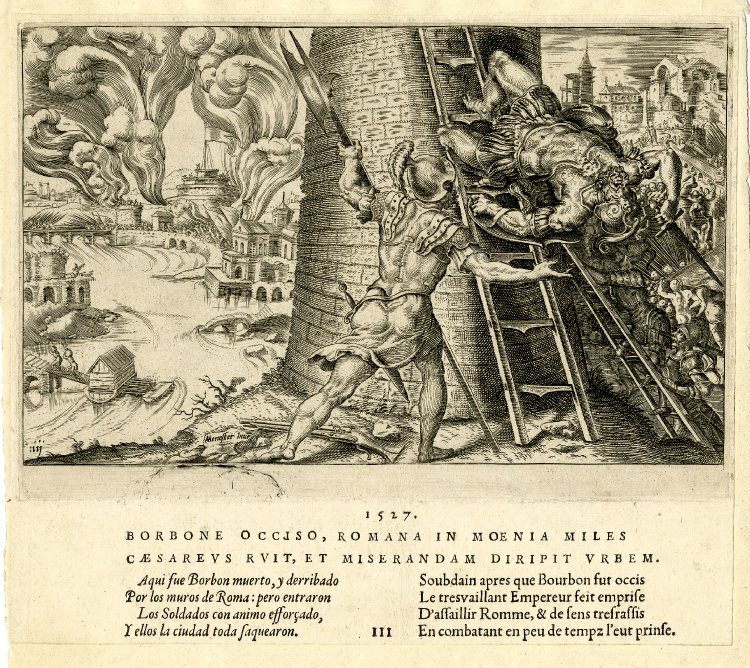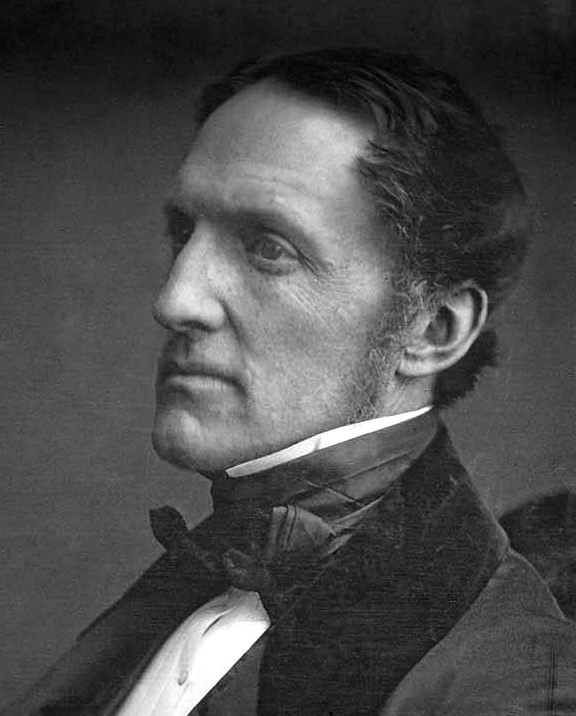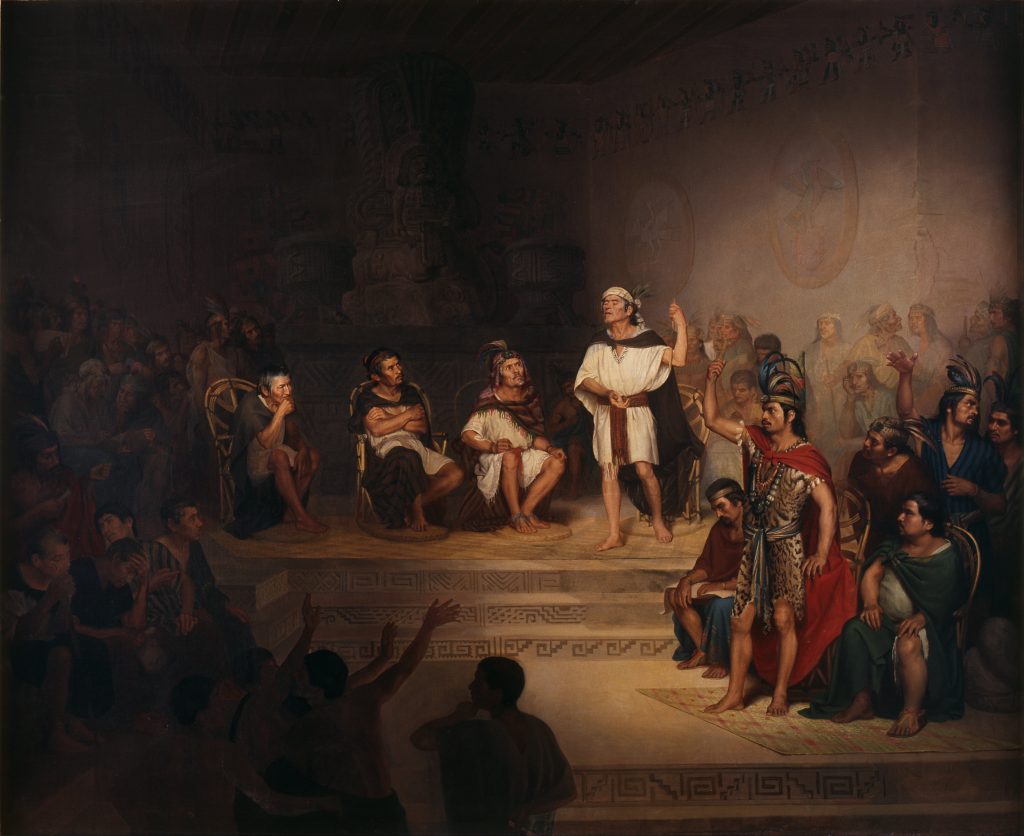
The Black Legend example. Sack of Rome on May 6, 1527. Engraving by Martin van Heemskerck (1498-1574)
In the course of three or four days, the Spanish general furnished the Tlascalans with the opportunity so much coveted, and allowed their boiling spirits to effervesce in active operations. He had for some time meditated an expedition to reconnoitre the capital and its environs, and to chastise, on the way, certain places which had sent him insulting messages of defiance and which were particularly active in their hostilities. He disclosed his design to a few only of his principal officers… With as blithe and manly a step as if they were going to the battle-ground, they defiled through the gates of the capital, making its walls ring with the friendly shouts of “Castile and Tlascala.”[1]
William H. Prescott, History of the Conquest of Mexico, 1843
As the United States expanded during the nineteenth century interest in Spain and Latin America increased among Americans. This was particularly true during the late 1830s and early 1840s after the emergence of the Republic of Texas. Informing the increasing interest was a retrospective and romantic perception of the Napoleonic War in Spain that took place between 1808 and 1814. An examination of the press prior to and during the war demonstrates that the looming conflict with Mexico ushered in an era of interest in Spanish history. Miguel González-Gerth, a longtime professor of Spanish at the University of Texas, wrote in his 1962 article, “The Image of Spain in American Literature, 1815-1865,” that even though eastern cities such as New York and Boston represented “offshoots of English Metropolitanism,” it was the nineteenth century when Americans were “discovering Hispania.”[2] González-Gerth noted that “variant American attitudes towards Spain in the Peninsula and Spain in the Americas” were informed in part by “the average American’s desire for romantic escape…” These attitudes were derived from contemporary events that included both the “Spanish-American struggle of independence (1810-1824), as well as that of the French occupation of Spain (1808-1813).”[3]
Black Legend and Prescott’s Paradigm
Accompanying an increasing interest in Spain during the antebellum era was a repackaging of the “Black Legend” – a cultural and racial stereotype that became a long-held historiographical generalization. The Black Legend (la leyenda negra española) traced its origins from anti-Catholic and anti-Spanish propaganda disseminated in Spanish-ruled Netherlands in the sixteenth century – from where it spread to England. The English opposed Spain’s dominance in European affairs during the Eighty Years’ War (1568-1648) and were eager to perpetuate the belief that the Spanish were corrupt and backward. Such beliefs appeared during the Latin American wars of independence (1808-1833) and reappeared in updated form on the eve of the US-Mexican War under the authorship of William H. Prescott.

Prescott’s 1843 The History of the Conquest of Mexico was popular among Americans prior to and during the war, and became a must-read not only for intellectuals and politicians, but for soldiers going off to fight America’s first large-scale foreign conflict. For that reason, the “Prescott Paradigm” – an expression coined by Richard L. Kagan in 1996 – portrayed Spain and its empire as the antithesis of U.S. institutional development and social progress, a perspective making it easier for Americans to justify invasion.[4]
Tlaxcalans and the Capital
Taken in that context, Prescott’s work reads like a romantic ethnographic blueprint legitimizing conquest (although he opposed the war). In the preface of his history, Prescott addressed the conquest of Mexico: “I have prepared the way for it by such a view of the civilization of the ancient Mexicans as might acquaint the reader… and enable him to understand the difficulties which the Spaniards had to face in their subjugation.”[5] More importantly for the Americans, and U.S. Army specifically, Prescott’s work identified major schisms existing between the many ethnic groups within Mexico.

In the case of Puebla – inhabited by the descendants of the Nahuatl-speaking Tlaxcala people – the city did not resist U.S. occupation and thus provided an important midpoint during the multi-month campaign to seize the Mexican capital. Prescott’s work highlighted how the Tlaxcalans aided Cortez in his conquest of the Aztec capital – which was ruled with sanguinary force and unpopular among the peoples of neighboring states. In essence, and unlike modern misconceptions, the Spanish-led campaign was not some mystical manifestation of ancient legends and power of superstition, but a strategic alliance between the Spaniards and tribal states long opposed to Aztec rule:
In a former page I have mentioned that it was the plan of Cortes, on entering the Valley, to commence operations by reducing the subordinate cities before striking at the capital itself, which, like some goodly tree whose roots had been severed one after another, would be thus left without support against the fury of the tempest. …eighteen horse[s], and three or four thousand Tlascalans. Their route lay along the eastern border of the lake, gemmed with many a bright town and hamlet, or, unlike its condition at the present day, darkened with overhanging groves of cypress and cedar, and occasionally opening a broad expanse to their view… Farther on, the eye ranged along the dark line of causeway connecting Mexico with the mainland, and suggesting many a bitter recollection to the Spaniards. They quickened their step, and had advanced within two leagues of their point of destination, when they were encountered by a strong Aztec force drawn up to dispute their progress. Cortes instantly gave them battle. The barbarians showed their usual courage, but, after some hard fighting, were compelled to give way before the steady valor of the Spanish infantry, backed by the desperate fury of the Tlascalans, whom the sight of an Aztec seemed to inflame almost to madness. The enemy retreated in disorder, closely followed by the Spaniards.[6]
Did the Americans know that the people of Puebla would be hospitable to them – as their ancestors had been to Cortez more than three centuries earlier? The short answer is ‘no,’ but knowing that they might be indifferent to a war brought to their doorsteps by the leaders of Mexico City meant the U.S. Army would do everything in its power, under the most efficient means possible, to divide and conquer. The Black Legend regarding Spain was inarguably a fabrication of agenda, but regarding the History of the Conquest of Mexico and the Tlaxcalans, sometimes there is truth to legend.
[1] William H. Prescott, The History of the Conquest of Mexico (New York: The Modern Library, 1843), 518, 550.
[2] Miguel González-Gerth, “The Image of Spain in American Literature, 1815-1865.” Journal of Inter-American Studies 4, no. 2 (Apr. 1962): 257. See: “When Turner Meets Prescott: A Historiographical Analysis of the Untold Connection Between the Napoleonic War in Spain and the Mexican-American War,” Entremons, UPF Journal of World History, No. 11 (Oct. 2020) www.entremons.org.
[3] Ibid. 259. González-Gerth claims “1815 is highly significant in the history of American literature, particularly where it concerns Spanish culture.” (Ibid. 257) Influential works of the era include Washington Irving’s Life of Columbus (1829), A Chronicle of the Conquest of Granada (1829), and Alhambra (1832). See also: David J Weber, “The Spanish Legacy and the American Imagination.” The Western Historical Quarterly 23, no. 1 (Feb. 1992): 5-24.
[4] Richard L. Kagan, “Prescott’s Paradigm: American Historical Scholarship and Decline of Spain.” The American Historical Review 101, no. 2 (Apr. 1996): 423-446.
[5] Prescott, The History of the Conquest of Mexico, 5. See: Richard L Kagan, Spain in America: The Origins of Hispanism in the United States (Urbana and Chicago: University of Illinois Press, 2002). See also: Christopher Schmidt-Nowara, “The Broken Image: The Spanish Empire in the United States after 1898,” in Endless Empire: Spain’s Retreat, Europe’s Eclipse, America’s Decline (Alfred W. McCoy, Josep M. Fradera, Stephen Jacobson, ed. Madison: University of Wisconsin Press, 2012): 160-166.
[6] Prescott, The History of the Conquest of Mexico, 507-508.
About the author
Benjamin J. Swenson is an assistant professor at Hoseo University in Asan, South Korea. He holds a PhD from Pompeu Fabra University in Barcelona, Spain, where his dissertation addressed Euro-American military history and the advent of guerrilla warfare and counterinsurgency doctrine in the nineteenth century. His work has recently appeared in the Journal of Military History, and his latest, The Dawn of Guerrilla Warfare, will be published by UK’s Pen & Sword in 2023. His hobbies include Viking sagas and chess.